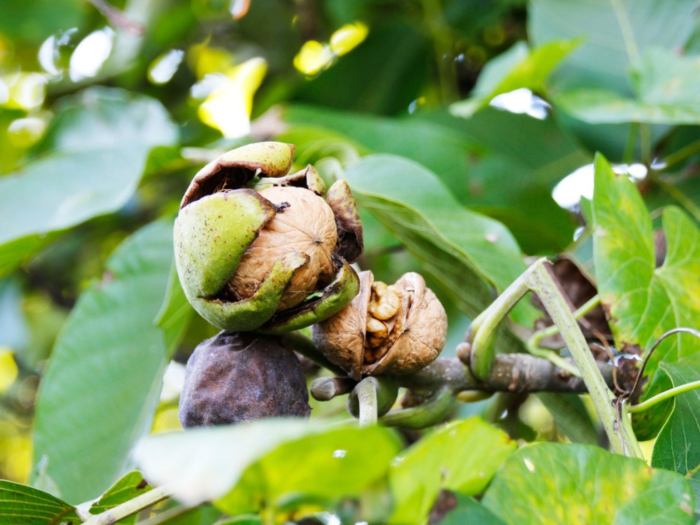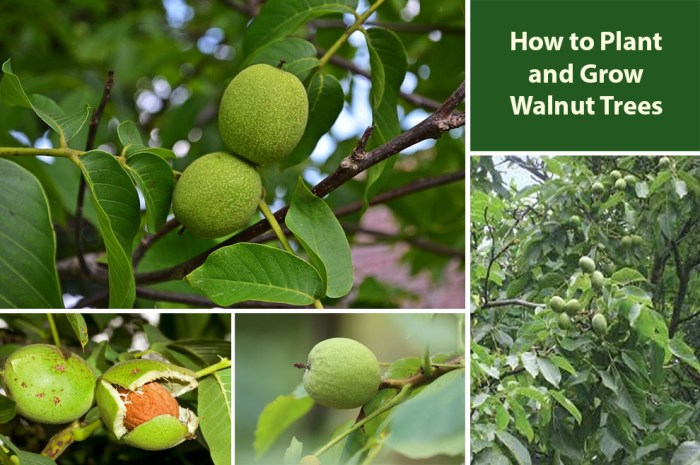How to Plant Walnut Seeds
Walnut Seed Planting: A Comprehensive Guide
How to plant walnut seeds – Planting walnut trees from seed can be a rewarding experience, offering a direct connection to nature and the potential for years of delicious harvests. This guide provides a step-by-step approach to successfully cultivating walnut trees from seed, covering seed selection, planting techniques, post-planting care, and seedling development.
Seed Selection and Preparation
Choosing viable seeds and preparing them correctly is crucial for successful germination. This involves selecting seeds with specific characteristics, cleaning them, and undergoing a process called stratification to mimic natural winter conditions.
Ideal Walnut Seed Characteristics: Look for plump, firm seeds that are free from cracks, holes, or signs of insect damage. The seed coat should be intact and a rich, dark brown color. Avoid seeds that are shriveled, lightweight, or discolored, as these are likely to be non-viable.
Seed Preparation: Begin by cleaning the seeds to remove any adhering debris. Gently scrub the seeds with a soft brush and rinse them thoroughly with water. After cleaning, the seeds need stratification. This process involves exposing the seeds to cold, moist conditions to break dormancy. A simple method is to place the seeds in a container filled with moist (not soggy) vermiculite or peat moss and store them in the refrigerator at 35-40°F (2-4°C) for 60-90 days.
Planting walnut seeds requires a bit of patience; you’ll need to stratify them first to mimic winter conditions. The process is quite different from, say, learning how to plant an avocado seed in dirt , which involves a simpler approach. However, both methods share the common goal of providing the seed with the optimal environment for germination and growth, leading to a healthy and thriving plant.
Once your walnut seed sprouts, consistent watering and sunlight will be key.
Seed Viability Test: To assess viability, soak a few seeds in water for 24 hours. Viable seeds will sink; those that float are likely not viable and should be discarded. You can also carefully crack open a few seeds to check for a healthy, firm embryo.
| Walnut Variety | Climate Suitability | Germination Rate | Growth Habit |
|---|---|---|---|
| Black Walnut (Juglans nigra) | Temperate, well-drained soil | Moderate | Fast-growing, large tree |
| English Walnut (Juglans regia) | Mild, Mediterranean climates | Good | Medium-growing, smaller tree |
| Persian Walnut (Juglans regia) | Similar to English walnut | Good | Medium to fast-growing |
| Butternut (Juglans cinerea) | Cool, moist climates | Moderate | Medium-growing |
Sowing Techniques
Walnut seeds can be sown directly outdoors or started indoors. Direct sowing is simpler but carries more risk, while starting indoors offers greater control but requires more effort. Soil preparation is vital for both methods.
Direct Sowing: Plant seeds in the fall, after the first frost, at a depth of 2-3 inches. This allows for natural stratification over winter. Ensure the soil is well-drained and amended with compost.
Indoor Sowing: Sow seeds in individual pots filled with a well-draining seed-starting mix in early spring. Keep the soil consistently moist and provide ample light. Transplant seedlings outdoors after the last frost.
Optimal Soil Conditions: Walnuts thrive in well-drained, slightly acidic to neutral soil (pH 6.0-7.5). Amend heavy clay soils with organic matter to improve drainage. Sandy soils may require the addition of compost to retain moisture.
Planting Schedule: Planting times vary depending on the variety and climate. Consult local gardening resources for specific recommendations for your region. Generally, fall sowing is preferred for direct sowing, while spring sowing is common for indoor starting.
Seedling Spacing: Space seedlings 30-40 feet apart to allow for mature tree size. This prevents overcrowding and competition for resources. Consider the mature size of the variety when planning spacing.
Planting Hole Preparation: Dig planting holes twice as wide and as deep as the root ball. Amend the soil with compost or other organic matter to improve drainage and aeration. This encourages strong root development.
Post-Planting Care, How to plant walnut seeds

Source: gardeningknowhow.com
Providing consistent care during the initial stages is crucial for the health and survival of young walnut seedlings. This includes proper watering, weed control, pest and disease management, and fertilization.
Watering: Water regularly, especially during dry periods. Aim to keep the soil consistently moist but not waterlogged. Reduce watering frequency as the seedlings mature.
Weed Control and Mulching: Regularly remove weeds to reduce competition for nutrients and water. Apply a layer of mulch (e.g., wood chips or straw) around the base of the seedlings to retain moisture, suppress weeds, and regulate soil temperature.
Pest and Disease Management: Monitor seedlings for signs of pests (e.g., aphids, walnut husk flies) and diseases (e.g., anthracnose, root rot). Implement preventative measures such as proper sanitation, appropriate watering, and the use of organic pest control methods if necessary. Consult local agricultural extension offices for specific recommendations.
Fertilizing: Young walnut trees benefit from fertilization to promote healthy growth. Apply a balanced fertilizer (e.g., 10-10-10) according to package instructions, usually in early spring. Avoid over-fertilizing, as this can damage the roots.
Protection from Extreme Weather: Protect young seedlings from harsh weather conditions, such as strong winds, frost, and intense sunlight. Consider using windbreaks, frost covers, or shade cloth as needed.
Seedling Growth and Development

Source: embracegardening.com
Understanding the typical growth stages and identifying signs of healthy versus unhealthy seedlings are essential for successful cultivation. Regular monitoring allows for timely intervention if problems arise.
Growth Timeline: Germination typically occurs within 2-4 weeks after planting. Seedlings initially develop a taproot, followed by the emergence of cotyledons (seed leaves). True leaves appear after a few weeks, and the seedling continues to grow throughout the growing season.
Healthy vs. Unhealthy Seedlings: Healthy seedlings have strong, upright stems, vibrant green leaves, and a well-developed root system. Unhealthy seedlings may exhibit stunted growth, wilting leaves, discoloration, or signs of disease or pest infestation.
Growth Rate Comparison: Growth rates vary depending on the walnut variety, climate, and soil conditions. Fast-growing varieties may show significant height increase in the first few years, while slower-growing varieties may exhibit more gradual growth.
Common Problems and Solutions: Common problems include damping-off (a fungal disease affecting seedlings), nutrient deficiencies, and pest damage. Address these issues promptly by improving soil drainage, providing appropriate fertilization, and implementing pest control measures.
- Successful germination is indicated by the emergence of a radicle (primary root) and plumule (shoot).
- Healthy seedlings exhibit strong growth, vibrant green foliage, and a well-developed root system.
- Early growth is characterized by the development of cotyledons (seed leaves) followed by true leaves.
Visual Guide: Walnut Seed Germination
Observing the visual changes during germination provides valuable insights into the seedling’s health and development. This includes recognizing the stages of germination and identifying the characteristics of healthy and unhealthy seedlings.
Stages of Germination: The first visible sign is the cracking of the seed coat, followed by the emergence of the radicle (primary root). The plumule (shoot) then emerges, followed by the development of cotyledons (seed leaves). True leaves appear later, marking the transition to seedling stage. The entire process can take several weeks, depending on the variety and environmental conditions. Typical timelines vary, but generally, cracking can occur within a week to several weeks of stratification, followed by root emergence within another week or two, and shoot emergence shortly after.
Healthy Root Systems and Stems: Healthy roots are thick, white, and well-branched, indicating strong establishment. Healthy stems are firm, upright, and free from discoloration or lesions.
Appearance of Unhealthy Seedlings: Unhealthy seedlings may exhibit symptoms such as wilting, yellowing or browning leaves, soft or mushy stems, and stunted growth. These could indicate problems such as damping-off, nutrient deficiencies, or pest infestations.
Popular Questions: How To Plant Walnut Seeds
How long does it take for a walnut seed to germinate?
Germination time varies depending on the variety and conditions, but generally takes several weeks to a few months.
Can I plant walnut seeds in the fall?
Yes, fall planting is often recommended in many climates, allowing for natural stratification over winter.
What type of fertilizer is best for young walnut trees?
A balanced, slow-release fertilizer suitable for fruit trees is generally recommended. Follow package instructions carefully.
How deep should I plant walnut seeds?
Plant seeds about 2-3 times their depth; usually 1-2 inches deep.





















